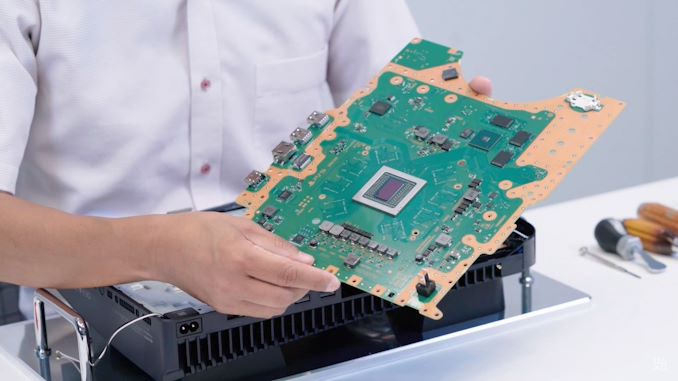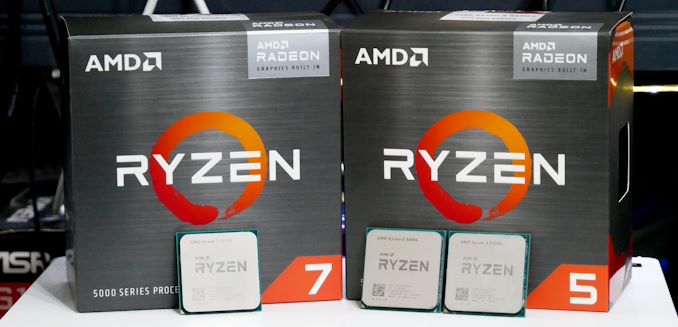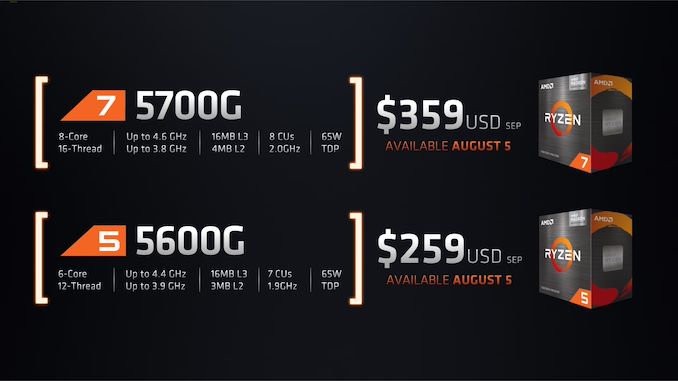The AMD Ryzen 7 5700G, Ryzen 5 5600G, and Ryzen 3 5300G Review
by Dr. Ian Cutress on August 4, 2021 1:45 PM ESTA Great Alternative to Regular Ryzen
I’m a big fan of a cheap and efficient solution for a PC that performs well and just works. Sometimes when building these systems, the fewer parts the better, as it means less can go wrong, but there is also a desire to ensure the system will last and remain fast during its tenure.
Historically a processor with integrated graphics fit the bill. They used to be a dime a dozen (or up to $150), and when paired with a good small motherboard and a couple of memory modules, an SSD, and a good stock cooler, then someone like my father can browse the web and do office stuff on his 32-inch display and join the weekly family zoom call without having to sit there for the system to respond.
What AMD has here with the new Ryzen 5000G desktop APUs is something that fast. Equipping up to eight Zen 3 cores around 4.0 GHz in a system should cater to almost* everyone’s compute needs. The new 5000G APUs are generationally a really nice improvement in raw compute performance over 4000G, but because 4000G wasn’t really at retail, we’re looking at 3000G, and the new hardware wipes the floor here. The only downside is that AMD didn’t release the cheapest offering.
Only the Ryzen 7 5700G ($359) and Ryzen 5 5600G ($259) are coming to market. Both of these processors are around about the same performance as their desktop variants (5800X and 5600X), so it probably won’t be much of a surprise to see these parts in our CPU guides going forward where we would normally recommend the X processors. The problem with these though is that the 5300G isn’t coming to market, at something like $159.
The Ryzen 3 5300G has been a fun processor to test. In every test it surpasses the previous retail APU flagship (the R5 3400G), and even if we compare it to the OEM flagship the R7 4750G, in a few tests it beats it there as well, both in regular performance and in gaming.
So why isn’t AMD selling the Ryzen 3 5300G at retail? Perhaps because it doesn’t need to. Demand for AMD’s regular processor lineup has been strong, and it is only recently where we’re seeing processors like the 5600X and 5800X come back down to MSRP and in stock regularly. AMD makes more profit on those processors (probably), so it would rather sell those. By keeping the 5300G behind, it drives users up to the mid and high-tier 5000G parts, increasing the average selling price and revenue. And in a market where all silicon seems to be being sold, it’s a clever productization tactic. The 5300G at a $159 price point would have a special place in many builds. Until that time, users will have to make do with a 5600G.
The Ryzen 7 5700G and Ryzen 5 5600G go on sale tomorrow, on August 5th 2021.
Do APUs Make Sense For Gaming Yet?
Ever since graphics hardware has been attached to CPU cores, we’ve always wondered: ‘At what point can it be powerful enough to consume the entry-level market?’. Theoretically, year on year, the graphics capabilities of what is in the silicon has improved, and we get speed increases in the same way we see CPU core performance increases. However it is not always the silicon that matters.
Games are also getting more complex. In the same way that every year we get more performance, every year the required specifications for modern games go up. Developers get ambitious, and they want to convert their artistic vision onto a system, and there are often two main targets for those developments: playable on consoles, and the best experience on a super expensive PC. This creates a problem for the lowly integrated graphics solution, because they end up powered well below that of consoles.

A PS5 Processor with Integrated Graphics
Consoles have the added benefit of being a hyper-optimized and well-defined platform: the software stack is built on gaming performance and developers can cater to it. Because integrated graphics can come in many different shapes and colors, we’re relying on some of those optimizations to filter down. Not only that but new technologies such as AMD’s Fidelity SuperFX Resolution are aimed at getting a better experience with less compute power. While game requirements are getting higher, at least the tricks to get better performance are also coming along.
So why not build a big integrated graphics solution for desktops, like a console? First is the market optics – realistically AMD is the main vendor in the console game but also the only vendor taking integrated graphics solutions seriously, so there’s no desire to cross-contaminate each market segment. Second is the market size – a discrete GPU, even one at 75 W, doesn’t have to compete with a joint power budget with a CPU, whereas an integrated solution does, and how many users really want a joint power budget for a main gaming system? One could easily argue that APUs make sense for those on a budget, or someone looking for a smaller system without a discrete card, and not a lot else.
On a budget, you could easily build a Ryzen 5 5600G gaming system with good recommended components for $621, providing you with almost the best integrated gaming experience while at the same time performing near-the-same or beating last generation’s flagship APU in day-to-day tasks. Moving up to Zen 3 with a larger L3 cache has really unlocked more of the performance in these cores and in the graphics.
One of the big questions on the horizon is regarding how AMD might use its 3D V-Cache technology in the future. The current implementation is a 64 MB die that sits on top of the cache in a regular CPU chiplet. That same chiplet won’t work on an APU, but AMD could very much design one in a similar fashion for its integrated graphics – perhaps adding another 32 MB of L3 cache. The question on that then becomes how much extra will it cost, and whether the trade-off is worth it. At a time where discrete graphics solutions are still crazy expensive, it is perhaps not as farfetched as you might think. However, based on AMD’s disclosures, don’t expect a chip like this anytime soon.












135 Comments
View All Comments
mode_13h - Monday, August 9, 2021 - link
> RAMBUS was supposed to unlock the true power of the Pentium 4I think Intel underestimated what the DDR consortium was capable of doing. Perhaps they were right, as the DDR makers were eventually forced to license some RAMBUS patents, as I recall.
> the Willamette I used for a decade had plain SDRAM, not even DDR.
Northwood was the best. Sadly, I bought a Prescott because I wanted hyperthreading and hoped the 2x L2 cache would compensate for the longer pipeline. But, it turns out you could even get hyperthreading and 800 MHz FSB, in a couple Northwoods. I also thought SSE3 might be useful, but never got around to doing anything with it.
BTW, I also used DDR400 in my P4.
GeoffreyA - Tuesday, August 10, 2021 - link
For me, both the Prescott and A64 were available, but I went with the latter because I always wanted an Athlon. Originally, was looking at the XP 3200+ and dreamt of coupling that with an nForce2 motherboard. As for Northwood, masterpiece of a CPU. P4 would have put up a respectable defence against the A64 had they continued with it. My aunt had a 2.4 GHz Northwood back then, and my school friend a 2.66 GHz one. His struggled at first, but once he got more RAM and a GeForce FX 5700, it really flew. Still remember running through Delta Labs in Doom 3 at 60 fps!mode_13h - Wednesday, August 11, 2021 - link
Prescott was rumored to have 64-bit support, though it wasn't enabled. I think that explains some of the additional pipeline depth.When Core 2 first launched, I was skeptical the IPC could increase so much that so much lower-clocked CPUs would really outperform their predecessors. It took me a little while to fully accept it. I was hopeful the final 65 nm iteration of Pentium 4 would finally let the Netburst architecture stretch its legs, but even that couldn't overcome its inefficiencies and other deficits.
GeoffreyA - Friday, August 13, 2021 - link
Quite likely. Come to think of it, didn't the Pentium Ds have x64? And they were Prescotts.Indeed, 65 nm might have taken Northwood further. Would've made an interesting processor which we'll never see. As for their 31-stage brethren, the 65 nm Cedar Mills dropped power a fair bit.
GeoffreyA - Friday, August 13, 2021 - link
"65 nm might have taken Northwood further"Well, we didn't even get to see a 90 nm one.
coolrock2008 - Wednesday, August 4, 2021 - link
Ryzen 5 APUs Table, there is a typo. the 5600G is listed as an 8 core part whereas its listed as a 6 core part in the previous table.Wereweeb - Wednesday, August 4, 2021 - link
I know how hard it is to actually publish something that is both excellently researched and at a moment the matter is still relevant. Thank you for your coverage.Plus, it's Anantech, the important parts here are the data and analysis, not how well a tired writer proofreads their own text.
Fulljack - Friday, August 6, 2021 - link
I disagree. any researcher would say that proofreading are also as important as the analysis itself. it's how you serve the data and the analysis to broader audience, after all.dsplover - Wednesday, August 4, 2021 - link
Three times the IPC of my beloved i7 4790k’s. I’ll try one, maybe a few as I don’t need the fastest.The cooler, fast enough is fine for my 1U builds.
Thanks AMD. Tiger Lake never appeared, you win.
dsplover - Wednesday, August 4, 2021 - link
I meant 30% more IPC…